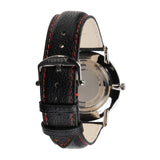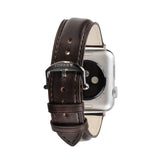For many people, a wristwatch is a daily use accessory that they cannot leave home without. For others, it is an accompaniment to an outfit to be used on special occasions or, with the rise of smartwatches, a tool to track physical activity. Understanding the history that has led watches to where they are today, will allow you to truly appreciate the beauty and intricacies of the wristwatch.
Measuring Time over History
The entire concept of measuring time stretches back to the beginnings of recorded history. In around 3,500 B.C., the Ancient Egyptians relied on the Sun to keep track of time, using "obelisks" now referred to as shadow clocks. From there they created and used sundials to help determine the time. The oldest known sundial from Egypt date backs to around 1,500 B.C.
While you may look at modern clocks and wristwatches and consider them extremely more technologically advanced than ancient sundials (and you’d be right), it’s also worth noting that the circular design of Egyptian sundials helped to shape and inspire the appearance of modern watches.
One of the more interesting historical creations is an early prototype of an alarm clock, created in ancient Greece around 250 B.C. They created a water clock, whereby the gradual rise and running of water would keep track of time and eventually trigger a mechanical bird to whistle. Although water clocks were initially not as accurate as sundials, they did prove more useful, given that they could be used indoors, through the night and didn’t rely on clear skies.
In the 8th century the hourglass was created which proved to be a slightly more accurate time-measurement device and were commonly used in churches. A monk, who later became Pope Sylvester II is often credited with the invention of the first mechanical clock, circa 996. Clocks became a necessity in daily church life with monks calling others to prayer.
Later, monks began to create more sophisticated clocks and clock towers whereby they became more visible to the ordinary population.
The Pocket Watch
Watches were made possible in the early 15th century due to the creation of a mainspring. This is essentially a wound-up metal ribbon that functions as a power source. The pocket watch was the first portable time piece, invented by Peter Henlein in Nuremberg, Germany in 1504. It is believed that at this stage, Henlein’s pocket watch was not very accurate. The first recorded use of a watch on a wrist was from French philosopher Blaise Pascal who tied his pocket watch to his wrist with a piece of string.
Who Created the First Wristwatch?
The creation of the first wristwatch is something which is widely discussed among horologists. Guinness World Records have credited the creation of the first wristwatch to Swiss watch maker Patek Philippe in 1886 who created the piece for the Countess of Hungary. However, the first wristwatch may have been created in 1812 by Abraham-Louis Breguet, who is suspected to have created a timepiece to be attached to the wrist with a strap for Napoleon’s sister, Queen Caroline Murat.
When Did the Wristwatch Become Popular?
It wasn’t until the 20th century that wristwatches began to see a rise in popularity. Over time pocket watches became more advanced, and (more importantly) accurate, and remained the preferred choice of time piece for most men. The practicality of the pocket watch came into question because of technological advancements elsewhere. One of the more well-known stories was that Louis Cartier developed the first modern wristwatch for his friend Alberto Santos Dumont, who wanted to have the ability to be able to fly his plane with both hands and keep an eye on the time, which he was unable to do with a pocket watch. The Cartier Santos was created for this purpose and remains a central part of the series to this day.
Although wristwatches weren’t reserved for military use, men began to wear them for tactical reasons, rather than fashion. With a wristwatch, they could be synchronized, so that an attack could be launched without the possibility of alerting the enemy, whereby previously a signal would have made, potentially alerting others to the plan. When used for these purposes, these watches also needed to be a lot more durable than their predecessors to survive trench warfare. The outbreak of World War 1 further highlighted the value of a durable wristwatch and instances where hands-free tasks and timekeeping were essential.
As such, wristwatches became more popular among the public, and to this day you will find many watches with features that stem from military use such as navigation tools, scratch resistance glass and readability in low light.
Quartz Watches
A short time later, watch makers began looking for ways to produce electric powered watches. The idea was to create a watch which didn’t need to be worn or kept in a watch winder to keep time. In 1959 Seiko began working on a quartz crystal and battery powered watch. They had a working prototype in 1964, and at the summer Olympics the Seiko Quartz watch was used to time events.
In 1969, quartz watches hit the general market, where in place of a mechanical wheel (as with previous watches) quartz watches used a digital counter. Over time these would become increasingly popular since they were relatively cheap to make and often more accurate than a good number of mechanical watches during the same period.
Modern Mechanical Wristwatches
The mechanical watch market began to see return to popularity in the 1980s. By, generally, sitting within a higher price segment they were perceived as more “luxury” and thus became an aspirational product to own. Swiss-made became a tag which assured premium quality and largely dominated the watch market. The prestige of a mechanical watch remains strong to this day.
The Origins of the Smartwatch
It may surprise you that transition towards the smart watch began in the 1990s, when in 1994, the Timex Datalink became the first watch which was capable of wirelessly downloading data. This was Microsoft’s first foray into the market, and was used by NASA in space travel missions, highlighting its ingenuity for the time.
The Linux Smartwatch was created in the late 90s by Steve Mann, who is regarded as the father of wearable computing. The Linux Smartwatch was design to communicate wirelessly with PCs, cell phones and other wireless-enabled devices. It had the ability to view condensed emails and later enhancements were to include applications that allowed the watch to be used for internet-based services such as weather information, traffic conditions and the stock market. Starting to sound a bit familiar?
2004 saw Microsoft step back into the space with SPOT (Smart Personal Object Technology) Smartwatch. This was the first attempt of a smart watch as we know them today. With hindsight, the project is a large step into the prevalence of wearables and personalised technology, however Microsoft made the choice to limit it to its own ecosystem. It was developed around the idea of presenting digital information in a non-distracting way, but unfortunately for Microsoft, in the early 2000s, that information just wasn’t useful enough.
The Modern Smartwatch
Since then, a wide variety of companies have attempted to break into the smart watch market. Pebble made waves in 2012/2013 with its $10 million Kickstarter campaign, causing a massive shift in the watch market. Capable of operating as a remote control for a smartphone and with a range of notifications, Pebble’s successful campaign alerted the major tech companies that the consumer demand for smartwatches was there. Unfortunately for Pebble, with Apple and Samsung soon coming to play, they couldn’t keep up, before eventually being acquired by Fitbit.
Samsung started with the Samsung Galaxy Gear, which was announced in 2013. This proved to be a critical flop and was regarded as a product released simply to try and beat Apple to the punch. 2014’s Samsung Gear S later came with greater acclaim. It was Samsung’s first smart watch that offered 3g connectivity and 360x480 screen and was by far and away the best available at the time.
In September of 2014, the Apple Watch was unveiled and officially signalled a new era of smartwatches. In 2014, global smart watches sales totalled 4.2 million, in 2015 after the launch of the Apple Watch they rose to 19.4 million, with Apple estimated to account for 11.6 million of those.
Since then, both Apple and Samsung smartwatches have continually grown from strength to strength. With features like heart rate notifications, ECG and fall detection accompanying the mastering of notifications, connectivity, and fitness friendly features, we’re in an era where the smartwatch is fast becoming a necessity, rather than a luxury. Although some will argue that they will never replicate the beauty and prestige of a luxurious mechanical watch.
What’s Next?
Today, you can customise your watch with a new leather watch strap, whether that be a traditional watch or an Apple Watch. It’s difficult to see where the next evolution of the watch will come from. At this stage, its seemingly possible that the next big wearable technology breakthrough will come in the smart glasses and augmented reality space, putting connected features right in front of our eyes, rather than on our wrists.



